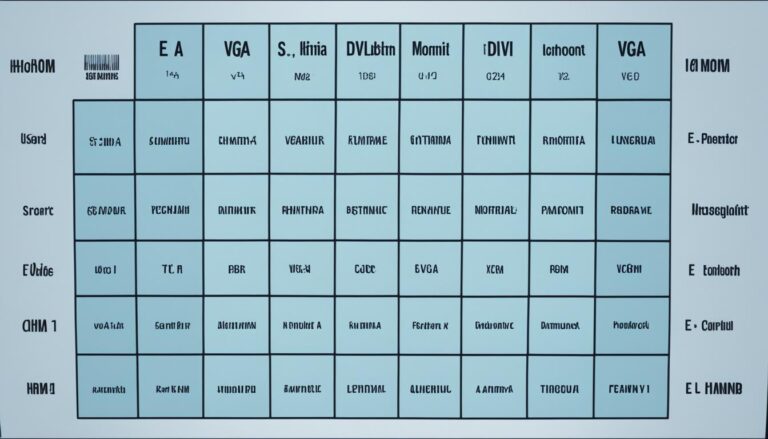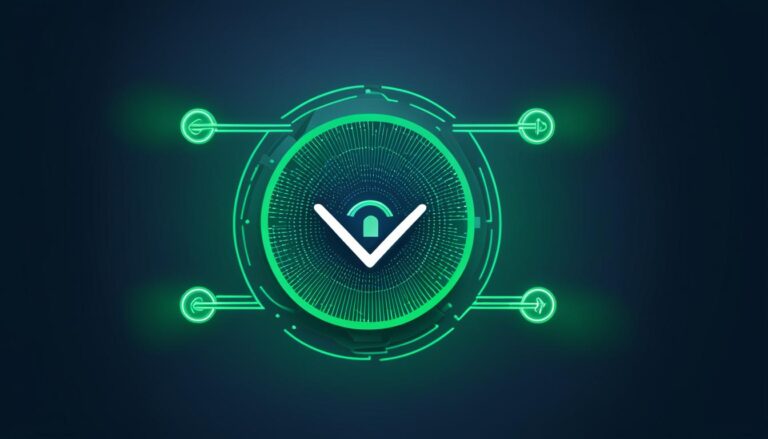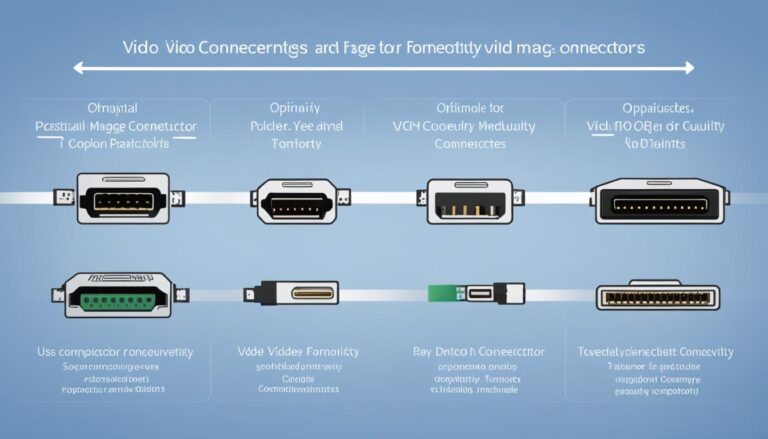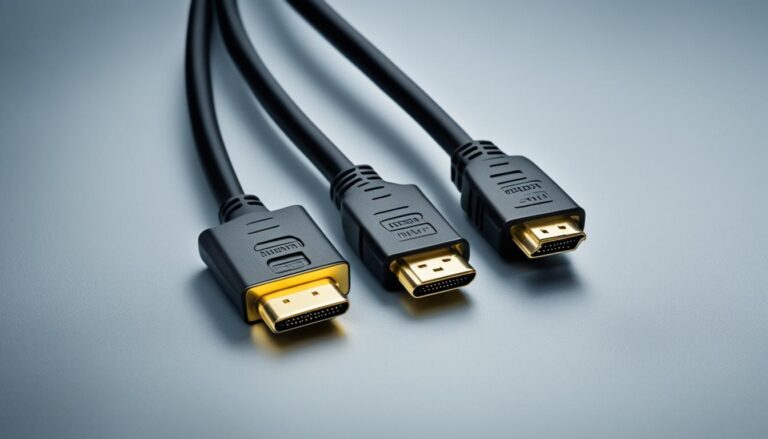Understanding the differences between VGA and the Serial Port is key when choosing the right connection for your monitor. Each has its own pros and cons. These can affect your monitor’s performance and quality.
VGA, or Video Graphics Array, is often chosen for analog video signals. It uses a 15-pin connector. However, VGA can’t be directly connected to the Serial Port, even with an adapter.
The Serial Port, or RS-232, connects devices like mice. It has a nine-pin connector. But, it’s not for video transmission or monitor connections.
Choosing between VGA and the Serial Port for your monitor setup requires careful thought. VGA suits analog video signals but the Serial Port doesn’t support video. For top video quality, consider HDMI, DisplayPort, or DVI. Always check device compatibility before deciding.
VGA – The Analogue Video Connection
VGA stands for Video Graphics Array, a popular choice for linking monitors to computers. It sends analogue video signals through a special cable. This cable has a D-sub 15-pin connector, known as DE-15F, which allows it to carry analogue RGB signals and sync signals.
VGA monitors must use a D-sub 15-pin connector. Trying to hook up a VGA monitor to a Serial Port with an adapter won’t work since their pinouts don’t match. VGA uses a standard pinout for video, unlike Serial Port, which doesn’t handle video signals at all.
Even though VGA is older, many devices still use it for analogue video. It’s compatible with lots of monitors and graphics cards, making it pretty handy. But, VGA might not handle high-resolution video or sound as well as newer connections like HDMI or DisplayPort.
VGA is great for analogue video with good quality on compatible monitors. Just make sure your devices have the right D-sub 15-pin connectors for the VGA link.
| Pin Number | Signal Name | Description |
|---|---|---|
| 1 | Red | Analogue Red signal (0-0.7V) |
| 2 | Green | Analogue Green signal (0-0.7V) |
| 3 | Blue | Analogue Blue signal (0-0.7V) |
| 4 | N/A | N/A |
| 5 | Ground | Signal Ground |
| 6 | Red Ground | Ground for Red signal |
| 7 | Green Ground | Ground for Green signal |
| 8 | Blue Ground | Ground for Blue signal |
| 9 | N/A | N/A |
| 10 | Sync Ground | Ground for Sync signals |
| 11 | N/A | N/A |
| 12 | Data Carry Over (DCO) | Optional control signal |
| 13 | Horizontal Sync (HSync) | Analogue horizontal sync signal |
| 14 | Vertical Sync (VSync) | Analogue vertical sync signal |
| 15 | Data Size/ID Bit 0 (reserved) | Optional control signal (reserved) |
Serial Port – Connecting Serial Devices
The Serial Port, also known as RS-232, connects devices like mice. It uses a DE-9 connector, a type with 9 pins.
The Serial Port can’t transmit video, so you can’t connect a monitor to it. It’s different from VGA in pinouts and functionality. For monitors, use VGA or HDMI.
Factors to Consider for Your Monitor Setup
When picking the right connection for your monitor, several factors matter. Choosing between VGA and Serial Port affects video quality and sound. It also impacts performance and resolution.
Analog Video Transmission and Video Quality
VGA allows for analog video, which is good for older devices. But, VGA might not give you the best video quality. If you want top video quality, think about HDMI or DisplayPort instead.
Resolution and Display Compatibility
Think about your monitor’s resolution and if it works well with your connection. VGA might not handle high resolutions well. HDMI or DisplayPort can offer clearer images and work better with newer monitors.
Audio Transmission and Connectivity
If your setup needs sound, VGA might not cut it. VGA only sends video, not sound. HDMI can send both, making your setup simpler and your experience better. Consider what your monitor needs before choosing.
Compatibility and Future-Proofing
It’s also key to think about whether your connection fits with your current and future devices. VGA is older and might not work with new devices. HDMI, DisplayPort, or USB-C are more modern and versatile, making your setup future-ready.
Other Types of Monitor Connections
There are many types of monitor connections beyond VGA and Serial Port. These include HDMI, DisplayPort, DVI, and USB-C. Each has unique benefits.
HDMI:
- HDMI combines audio and video in one cable. It’s great for many devices like TVs and gaming consoles.
- It supports high resolutions and works with lots of devices.
DisplayPort:
- DisplayPort delivers high-quality audio and video. It’s very versatile.
- It can link multiple monitors together and supports high refresh rates.
DVI:
- DVI is favoured by gamers for its high frame rates on 1080p monitors.
- It can handle analog and digital signals, suitable for various monitors.
USB-C:
- USB-C can replace HDMI or DisplayPort. It’s very versatile.
- It’s fast for data transfer and can power devices while outputting video.
Different monitors use various ports and connectors based on needs. The right connection depends on the devices you use and the quality you want.
Choosing the Right Monitor Cable
The choice of monitor cable is key to a great monitor setup. Each cable has its own strengths and downsides. It’s vital to think about what you need. Let’s look at some popular monitor cables and what they offer:
HDMI – Simultaneous Audio and Video Transmission
HDMI cables are perfect for people who want audio and video together. They work well for gaming, streaming, and watching movies. HDMI supports high-quality video and audio.
DisplayPort – High-Quality Audio and Video Signals
DisplayPort cables are great for high-quality audio and video. They connect well with many devices. They support high-resolution video, let you use multiple displays, and are good for gaming.
DVI – Highest Refresh Rates at 1080p
DVI cables are good for gamers who want the best refresh rates at 1080p. They work well with gaming monitors. But remember, DVI doesn’t carry audio, so you might need another cable for sound.
VGA – Considerations for Video Quality
VGA cables have been around a long time. They don’t offer the best video quality compared to newer cables. VGA is an analogue connection with limited resolution and refresh rate. Think about this if video quality matters to you.
When picking the right monitor cable, think about sound, resolution, and refresh rate you want. Knowing what you need helps you choose wisely, making your monitor setup better.
Conclusion
Choosing between VGA and the Serial Port for monitors depends on your device needs. VGA offers good video quality for analog signals. But, it might not match other connections like HDMI or DisplayPort in performance.
The Serial Port doesn’t support video. It’s mainly for serial devices, like mice. If you want high-quality video on your monitor, consider VGA, HDMI, DisplayPort, or DVI. These options improve viewing experience.
Think about video quality, resolution, and audio when deciding. Remember, each monitor port and connector type, like HDMI or USB-C, has its pros and cons. Picking the right one will boost your monitor’s performance and quality.
FAQ
What is the difference between VGA and the Serial Port?
VGA is widely used for analog video. Meanwhile, the Serial Port connects devices like mice.
Can I connect a VGA monitor to a Serial Port using an adapter?
Sadly, no. VGA monitors need a D-sub 15-pin connector. It’s not the same as a Serial Port’s connectors.
Can I use the Serial Port to connect a monitor directly?
No, you can’t. The Serial Port isn’t meant for video. It lacks the proper pinouts and functionality for monitors.
What factors should I consider when choosing between VGA and the Serial Port for my monitor setup?
Consider video quality, resolution, and audio capacity. VGA supports analog video but might not offer the best resolution or audio.
Are there any other types of monitor connections available?
Indeed, several options exist. HDMI, DisplayPort, DVI, and USB-C are great for modern setups, each with unique benefits.
What is the best monitor cable choice for simultaneous audio and video transmission?
HDMI is top-notch for sending audio and video together. It eliminates the need for extra cables.
What is the best monitor cable choice for the highest quality audio and video signals?
DisplayPort is favoured by those who want superb audio and video quality.
What is the best monitor cable choice for the highest refresh rates at 1080p?
DVI is the go-to for high refresh rates at 1080p, especially for gaming enthusiasts.
Does VGA provide the same level of video quality as other connections?
VGA manages decent quality for analog signals but falls short compared to other options.
What factors should I consider when choosing between VGA and the Serial Port for my monitor setup?
Think about what you need, device compatibility, and the performance and quality you’re after.












